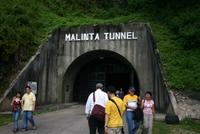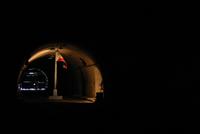Bid the island farewell
As I bid the island farewell after a day of historical rendezvous and astonishing discoveries, I recount some of the spots which captured my “patriotic spirit” the most. I consider these the more significant, or better yet, sacred places in Corregidor:
 The Pacific War Memorial on the center of the island stands as one of the greatest monuments of heroism and love for freedom.
The Pacific War Memorial on the center of the island stands as one of the greatest monuments of heroism and love for freedom.
On the northern tip, outsized bronze murals were used to recount pieces of Philippine history in an artistic fashion.
 In another part, a vast garden lies as a symbolic gesture of Japan’s remorse for the destruction they have brought to our people.
In another part, a vast garden lies as a symbolic gesture of Japan’s remorse for the destruction they have brought to our people.
 But nothing can compare to the “Malinta Tunnel Experience” – a 30 minute light and sound presentation inside the Malinta Tunnel itself.
But nothing can compare to the “Malinta Tunnel Experience” – a 30 minute light and sound presentation inside the Malinta Tunnel itself.
The total darkness gives the perfect background to revive the episodes at play during the most important days on Corregidor.  The smoke and dust effects added texture to the light and sound show, letting the tourist experience more intensely the narration about the fall of the island, the dramatic stories of soldiers during the war, and the great victory from the oppressors. The presentation ends with the playing of the Philippine National Anthem, a moment that would make every Filipino present very proud.
The smoke and dust effects added texture to the light and sound show, letting the tourist experience more intensely the narration about the fall of the island, the dramatic stories of soldiers during the war, and the great victory from the oppressors. The presentation ends with the playing of the Philippine National Anthem, a moment that would make every Filipino present very proud.
History is best appreciated if one can truly feel its true sense, how it contributes to the present and affects our future. These are what Corregidor has taught me, and I believe that I would be leaving the island more proud of my heritage.

 The hospital complex lies on top of a hill, but is enclosed by thick forest trees. The main path is almost unnoticed and enclosed by entangled shrubs and enormous tree roots that sprang out from the ground. Finding the hospital itself is a daunting adventure.
The hospital complex lies on top of a hill, but is enclosed by thick forest trees. The main path is almost unnoticed and enclosed by entangled shrubs and enormous tree roots that sprang out from the ground. Finding the hospital itself is a daunting adventure.


 What is left of the hospital are vast, dark and empty halls, punctured walls and columns resembling a skeleton of its remains. I couldn’t think but imagine how once it sheltered the injured especially during the heated moments of the war. Maybe the hallways of the hospital were filled with crying soldiers wounded from battle, while doctors and nurses run about to tend the more serious patients. I felt that Tita Judith, being a nurse herself, was moved by this experience.
What is left of the hospital are vast, dark and empty halls, punctured walls and columns resembling a skeleton of its remains. I couldn’t think but imagine how once it sheltered the injured especially during the heated moments of the war. Maybe the hallways of the hospital were filled with crying soldiers wounded from battle, while doctors and nurses run about to tend the more serious patients. I felt that Tita Judith, being a nurse herself, was moved by this experience.
 Only the whistle of the wind and chirps of birds were the sounds I heard that morning. There were no more screaming and other traces of human suffering left, but these will be forever etched on the sides and pillars of the ruins. I kept on telling Greg to take pictures in conspicuous spots – chances are the ghosts we’re seeking might appear on one of his photos.
Only the whistle of the wind and chirps of birds were the sounds I heard that morning. There were no more screaming and other traces of human suffering left, but these will be forever etched on the sides and pillars of the ruins. I kept on telling Greg to take pictures in conspicuous spots – chances are the ghosts we’re seeking might appear on one of his photos.




